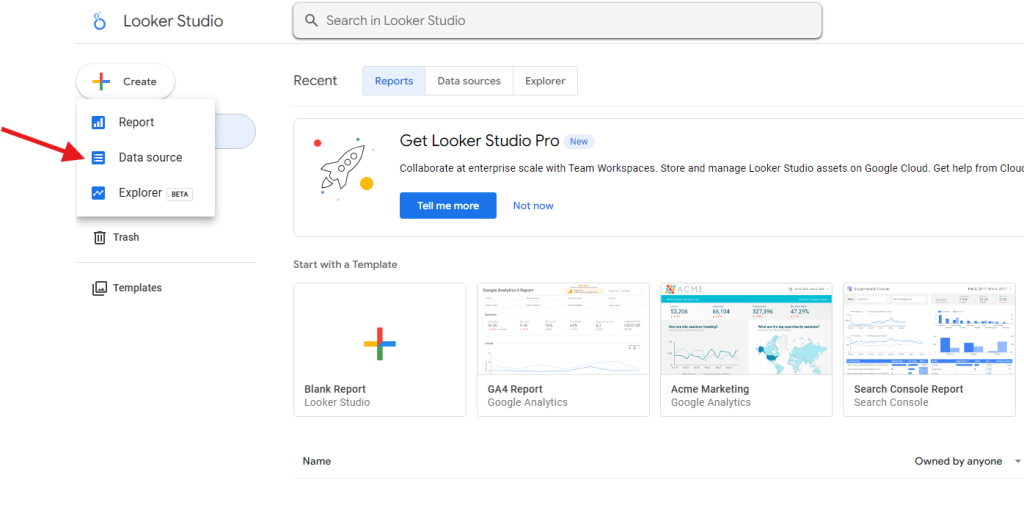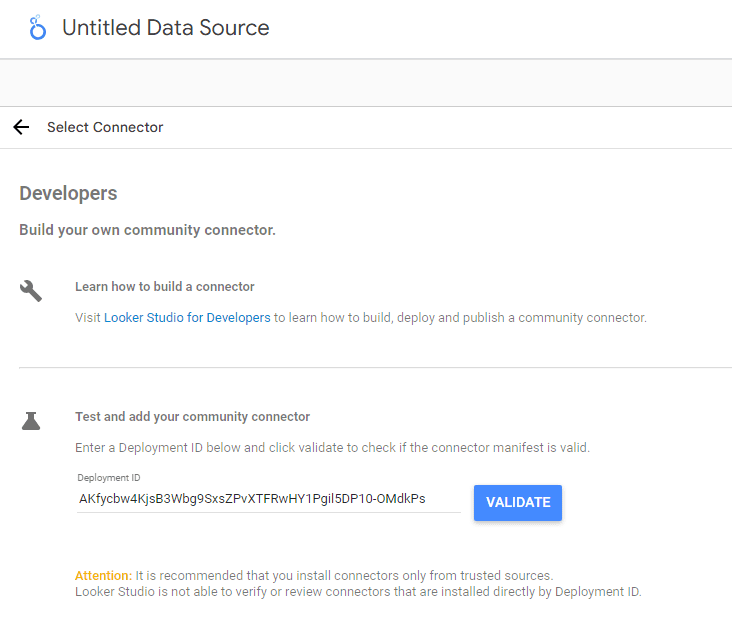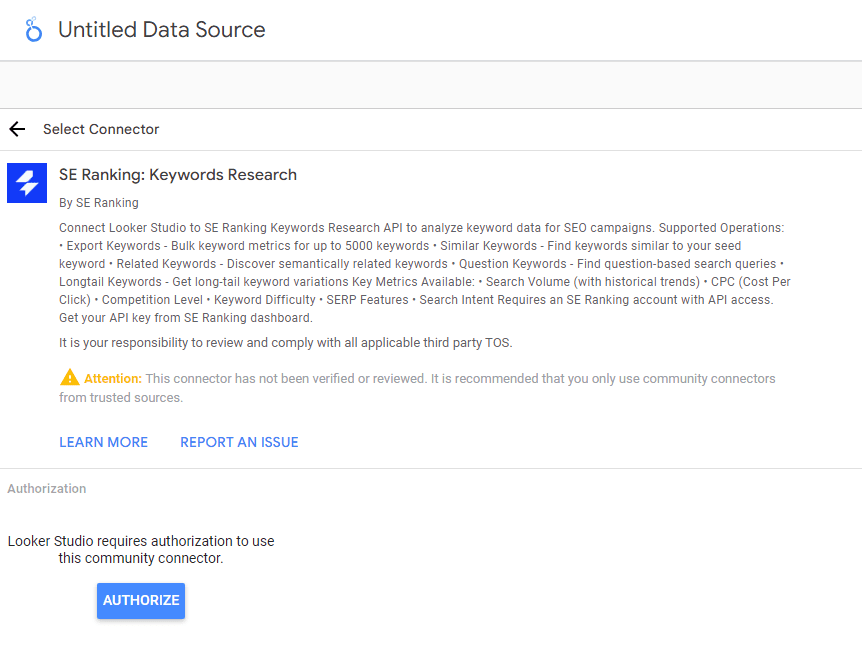Looker Studio
The SE Ranking and Looker Studio integration connects SE Ranking data directly to Looker Studio, Google’s free platform for reporting and data visualization. This connection enables you to create dynamic, interactive, and shareable dashboards for your SEO projects. Instead of manually exporting CSVs, you create automated reports for all your reporting purposes, like tracking keyword performance, analyzing competitor traffic, and monitoring your domain’s health in real-time.
What is Looker Studio for SEO?
Looker Studio for SEO acts as a visual reporting layer on top of your raw data. By connecting SE Ranking, you give Looker Studio the “context” it needs to understand your SEO metrics. This allows you to:
- Create custom reports: move beyond static reports and build dashboards tailored to your specific KPIs, whether it’s for internal analysis or client reporting.
- Visualize trends: turn historical data into intuitive time-series charts to see your organic traffic growth, keyword position changes, and more.
- Combine data sources: blend your SE Ranking data with other sources like Google Analytics, Google Search Console, and Google Ads to create a single, unified dashboard for all your marketing efforts.
This guide provides step-by-step instructions for connecting SE Ranking as a data source in Looker Studio.
Prerequisites
- SE Ranking account: you need an active SE Ranking account with API access. You can generate or find your API token in the SE Ranking API Dashboard.
- Google account: Looker Studio is a free tool available to anyone with a Google account.
Connecting SE Ranking to Looker Studio
Follow these steps to add an SE Ranking report as a new data source in Looker Studio:
1. Navigate to Looker Studio and click Create in the top left corner, then select Data source.

2. In the connector gallery, select Build Your Own (Partner Connectors).
3. You will be prompted for a Deployment ID. Copy the ID for the connector you wish to use (listed in the next section) and paste it into the field.
4. Click VALIDATE. Looker Studio will find the corresponding SE Ranking connector.


6. When prompted, provide your SE Ranking API token.
7. From the Parameters dropdown, select a particular operation or the All Operations (Combined) option.
8. Configure parameters per selected operation.
9. After parameters are configured, click CONNECT in the top right corner.
10. The SE Ranking data source is now connected. You can customize its fields and start building your report.
Repeat this process for each data source you want to add, or use the All Operations (Combined) mode if you prefer a unified data source.
Available SE Ranking connectors and operations
SE Ranking provides four unified Looker Studio connectors. Each connector has its deployment ID and includes multiple operations that you select inside Looker Studio after connecting.
1. Keyword Research Connector
Connector Deployment ID: AKfycbw4KjsB3Wbg9SxsZPvXTFRwHY1Pgil5DP10-OMdkPs
Below are the available operations within this connector:
| Operation | Description |
|---|---|
| Keywords Export | Metrics for a provided keyword list |
| Similar Keywords | Similar keyword suggestions |
| Related Keywords | Semantically related keywords |
| Question Keywords | Question-based keywords |
| Longtail Keywords | Long-tail keyword variations |
2. Domain Analysis Connector
Connector Deployment ID: AKfycbwJBz3g2of2OwfTGUUzzswQ5GbQRgcO_EUbgV2jGQHb
Below are the available operations within the connector:
| Operation | Description |
|---|---|
| Regional Database | Country-specific domain overview |
| Worldwide Aggregate | Global aggregated visibility |
| History Trends | Historical visibility trends |
| Domain Keywords | Keywords the domain ranks for |
| Domain Ads (Keyword) / Domain Ads (Domain) | Paid ads by keyword or by domain |
| Domain Competitors | Competing domains |
| Domain Keywords Comparison | Compare keywords between two domains |
3. Website Audit Connector
Connector Deployment ID: AKfycbx_A7utC6wgWW78eZ8saE5XbrjYCONfB37to4IkhbY3
Below are the available operations within this connector:
| Operation | Description |
|---|---|
| List Audits | View all your website audits |
| Audit Status | Check audit progress and status |
| Audit Report | Get audit scores and issue counts |
| Crawled Pages | List all crawled pages with metrics |
| Pages by Issue | Find pages with specific issues |
| Issues for URL | Get all issues for a specific page |
| All Links | View internal and external links |
| Audit History | View historical audit data |
4. AI Search Connector
Connector Deployment ID: AKfycbywqYyUBbkdB9h6N-sbq-3jQAMDhd3tm0W7tf09DKw
Below are the available operations within this connector:
| Operation | Description |
|---|---|
| Overview | Overall AI Search visibility summary |
| Prompts by Target | AI prompts grouped by target |
| Prompts by Brand | AI prompts grouped by brand |
Usage example: Building a keyword opportunity and risk dashboard
One practical way to use this integration is to track how your keyword positions change over time. By tracking new, lost, and shifting keyword rankings, you can spot opportunities and identify potential reasons for traffic loss.
- Connect the data source: connect the Domain Analysis connector using the steps outlined in Connecting SE Ranking to Looker Studio, then select the Domain Keywords operation.
- Add scorecards for position changes: add four scorecard components to your report. For each one, use “keyword” as the metric and apply a filter based on the
pos_changedimension:- New Keywords: filter
pos_changeto show only “new”. - Lost Keywords: filter
pos_changeto show only “lost”. - Improved Keywords: filter
pos_changeto show only “up”. - Declined Keywords: filter
pos_changeto show only “down”.
- New Keywords: filter
- Create an “Opportunities” table: add a table to your report to highlight positive developments.
- Data source: Domain Keywords.
- Dimensions:
keyword,url. - Metrics:
position,prev_pos,volume,difficulty. - Filter: apply a filter where
pos_changeis either “new” or “up”. - Sort: sort by
volumedescending to see your most valuable opportunities first.
- Create a “Traffic at Risk” table: add a second table to monitor potential issues.
- Data source: Domain Keywords.
- Dimensions:
keyword,url. - Metrics:
position,prev_pos,volume,traffic. - Filter: apply a filter where
pos_changeis either “lost” or “down”. - Sort: sort by
trafficdescending to prioritize the keywords that have the biggest impact on your traffic.
